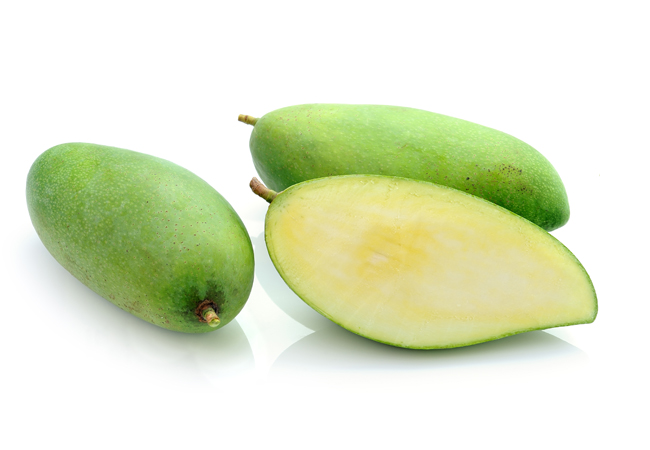Blog
Thai Mango Introduction

The Thai mango is known as “Ma Muang” in Thai, although this varies by region. For example, in the Northern region a mango is also known as “Pae,” and in the South as “Pao.” The mango is rich in symbolic meaning. As part of the feng shui tradition, for generations many Thais have believed that growing a mango tree on the south side of the house will bring prosperity to the family. More broadly, mangoes are so widely enjoyed in Thailand and surrounding countries that they truly do represent a precious part of the culture. There are perhaps more than one hundred types of Thai mangoes, many of them hybrids developed in Thailand. The mango tree only bears fruit once per year, and its season is between late March and early June. This is the time one will find delicately delicious mangoes – a fairly small window of time for top quality. Nevertheless, this small window of time represents much of the enjoyment of mangoes by so many in Thailand, making it in effect a staple for meals and especially desserts.
Thai mangoes vary in size, shape and color depending on the type, soil and harvest areas. The shapes of mangoes can be round, kidney-like in shape, oval, or a long slender shape. The color of a raw mango is typically green, but the color of ripe mangoes (the skin) can be yellow, yellow-green, green, yellowish orange or yellowish red. All mangoes have only one flat seed surrounded by flesh. Ripe mangoes have flesh that is yellow, golden-yellow, orange or orange-yellow.
The following are the most well-known mango types:
* Nam Dok Mai: oval with a sharp pointed tip. The ripe fruit has golden-yellow flesh with a sweet-scented taste;
* Kiaw Sa Woei: oblong dark green fruit. The ripe fruit has pale white flesh with a sweet taste;
* Thong Dam: oval with rounded tip. The ripe fruit has yellowish orange flesh with a sweet taste;
* Ok Rhong: oval with rounded tip. The ripe fruit has light yellowish orange flesh with a sweet taste;
* Raed: oblong with a small pointed knob. The ripe fruit has light yellow flesh with a sweet-scented taste;
* Pim Sian: oval with tapered tip. The ripe fruit has light yellow flesh with a sweet taste;
* Nang Klang Wan: oblong with curved and tapering tip. The ripe fruit has light yellow flesh and a sweet-scented taste.
As I experienced in Thailand, mangoes are eaten in a number of ways depending on the type of mango. Both ripe and raw mangoes are enjoyed as snacks. Nam Dok Mai, Nang Klang Wan, Thong Dam and Ok Rhong are usually served at the peak of ripeness. The most famous dessert is perhaps mangoes with sticky rice (Khao Niaw Ma Muang). Increasingly, this dish is being offered at restaurants in America as well. Kiaw Sa Woei, Pim Sian, Fah Lan and Raed are preferably eaten raw, even though they are also delicious as ripe mangoes. Well-liked dishes include Mango Salad (Yum Ma Muang – spicy shredded raw mangoes) and Crispy Shredded Catfish with Raw Mango Salad (Yum Pla Duk Foo).
When eating raw mangoes, dipping sauce is essential. The two common dipping sauces are:
* mixed of salt, sugar and crushed dry chilli, called Prik Gleua in Thai,
* mixed of chilli, fish sauce and palm sugar, heated to a caramel-like consistency, called Nam Pla Wan in Thai
Besides eating fresh and raw mangoes, Thais also use mangoes to make ice cream, juice and milkshakes, as well as pickled mango (Ma Muang Dong), dry pickled mango (Ma Muang Chae Im), or air dried pureed mango (Ma Muang Kuan). Since mangoes ripen so quickly and are abundant during the season, many mangoes are canned and sold, both domestically and internationally. Mango products are usually made from other types of mango such as Kaew, Chok Anan and Maha Chanok.
Thais not only use mangoes as fruit or in cooking, but in medicine as well. The following process is one example. The seed of the ripe mango is dried, and subsequently ground up or boiled in water. This process results in a drink which helps one with health problems such as a bloated feeling or to get rid of a parasite or worm. Another approach involves boiling 15-20 mango leaves with water to create a drink to treat bloated feelings, ulcerative colitis, or for other applications such as external use to clean wounds. Some drink water boiled with the bark of a mango tree to reduce fever. As always, consult a physician as appropriate before deciding on treatments.
Asian grocery stores in America often do not have Thai mangoes, but may have products made from Thai mangoes. In this case, if mango juice or mangoes with sticky rice sound appealing this summer, mangoes from the Philippines or Mexico are your best substitute. Costco often offers Mexican mangoes – wait until they are ripe – the skin will be very yellow. Mangoes from the Phillipines may be better, but they are equally if not more difficult to find.
As the vast majority of people in Southeast Asia eat mangoes, the cultural significance of the mango is broadly based. The mango has been a luscious and precious staple for generations. This is an ongoing result of both the high quality Thai mango itself, and the inspiration of its many delicious variations, uses, and cultural heritage.
Source: www.streetdirectory.com